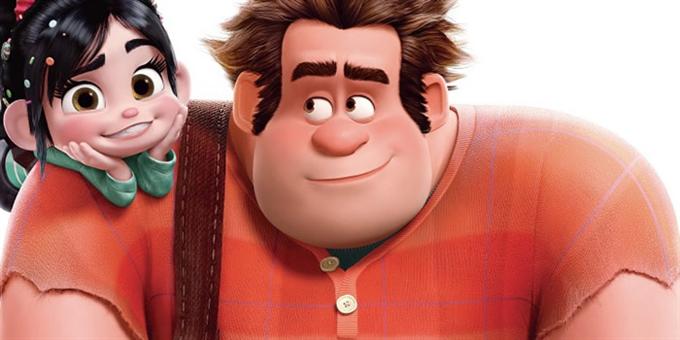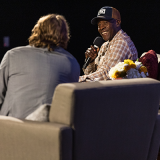Oscar-Nominated Animation RALPH BREAKS THE INTERNET: Q&A with Filmmaker Head of Story Jim Reardon (Wreck-It Ralph, Zootopia, WALL-E)
February 7, 2019
It’s film awards season, and the Disney animated film, Ralph Breaks the Internet, the sequel to Wreck-it Ralph, is receiving nominations left and right—from categories that range from best animated feature to outstanding visual effects.
As we anxiously wait for the outcome of all nominations this season, we take a look back at Jim Reardon’s visit to Dodge College. Over the past fall semester, Walt Disney Studios Motion Pictures invited the Chapman community to a screening of Ralph Breaks the Internet at Marion Knott Studios. The screening was followed by a Q&A session with head of story, Jim Reardon and moderated by our director of digital arts, Bill Kroyer.

Q: What were the challenges to making a sequel?
A: It’s tricky to do a sequel. Sequels tend to be repetitious, but we wanted to avoid that. We wanted to focus on the characters Ralph and Vanellope, and create a story based on the conclusion of Wreck-it-Ralph. Ralph asks a question, “if that little kid likes me, how bad can I be?” His character is putting all of his self-worth into this 9-year-old girl (Vanellope), and we saw an opportunity for more character development for both Ralph and Vanellope.
Q: Where do the ideas come from?
A: We sit in a room and talk it out. We work on it together. It’s about teamwork. Team work is a vital part of our process.
Meetings consist of criticism, weeding things out, and getting the opinions of those you trust and value. It’s helpful to remember that everyone wants the same thing—to make a good movie. Also, remember that every movie runs into a crash and burn moment at some point, so it’s best to get it wrong as soon as possible.
We redid this movie eight times. We put it up on reel eight times. I think there are 45 sequences in the movie; we boarded 154 sequences. So if you ever feel bad because you’re stuck when you’re making your film, don’t feel bad because we do it all the time.
Q: What are the responsibilities of the Head of Story?
A: The head of story runs the story crew, determines who is going to board which sequences, oversees writers and sits in on recordings.

Q: What makes a good story board artist?
A: It helps if you are a great artist, but can you convey the feelings of the character to the audience? Can you make me care about the character and make me understand them? You want the audience to feel what the character is feeling, and to see bits of themselves in the character.
Q: Tips for screenwriting?
A: Use the three-act structure: setup, confrontation and resolution. Create character archetypes—convey their wants and needs. Lastly, if you like a movie, go back to it— dissect it and ask yourself questions such as “what was the purpose of this scene?” and “how did it lead to the next scene?”
Q: What is the difference between a head of story and a director?
A: The head of story reads and deconstructs a script. They try to see what the director is trying to do. If we were on a ship, the head of story helps the captain get to their destination, which consists of constant communication with the captain and the crew. The head of story makes sure that no one feels left out in the process. In other words, the directors make the decisions and the head of story leads the crew to get behind those decisions. Also, even though directors make the final decisions, they do listen to feedback.

Q: What was the research and development process like?
A: We started by asking ourselves the question: “what does the internet look like?” When we did our research, we spoke to a lot of people, and we found that the best way to put it is: “a connection of tubes and wires”.
We understood the internet to be huge. In some shots we had 35,000 characters running around. To give you an idea of how complicated this was, we had to write whole new programs to create some scenes.
Q: Tips for storytelling?
A: I would never say there’s this fundamental truth to storytelling except to try to reflect the human condition. And whether we do that with robots or video game characters or talking foxes, it’s ultimately looking at ourselves. Hopefully, you have a statement you’re putting to the test when you’re making your movie. What is your theme? What are you questioning? What is it you’re putting up to the test to see if it’s true?
Q: How long did it take to produce Ralph Breaks the Internet?
A: We spent about four years on this film, because we were working on Zootopia in between production.
Q: What were the challenges of making a film relevant to adults, but marketed towards children?
A: First of all, I try to make these movies for myself, and I want to make them for all people. Disney tries to make everything for everyone, which is extremely difficult, but if you pull it off, it’s very rewarding. You’re also trying to make films relevant to all countries, but in this case, it was not a terribly difficult task when everyone uses the internet.
Fun fact: The Rescuers, Fantasia 2000, and Ralph Breaks the Internet are the only three Disney sequels that had a theatrical release.
Special thanks to Disney Studios Motion Pictures who invited the Chapman community to a screening of Ralph Breaks the Internet, to Jim Reardon for visiting Dodge College and taking time to shed light on the production of Ralph Breaks the Internet, and to Bill Kroyer, Director of Dodge College’s Digital Arts program for moderating this Q&A session.


